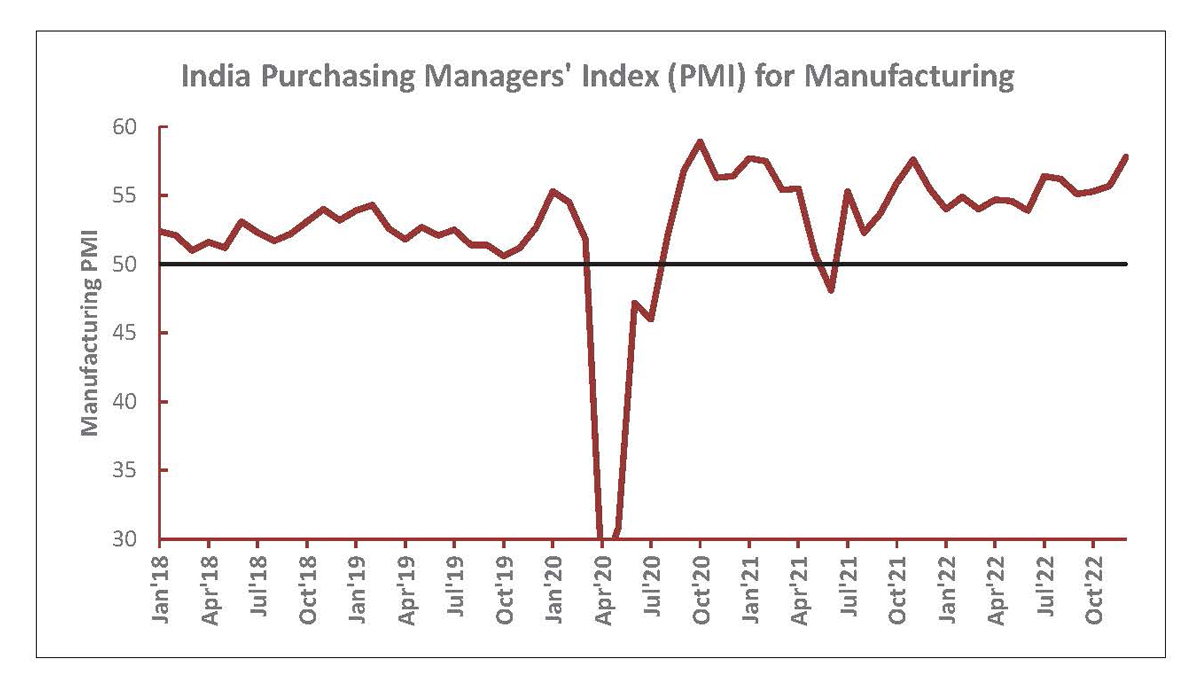
Macro and
Equity Market
Outlook
Equity Market
Outlook
Global Macro & Markets – Dec 2022
Indian markets fell in December, in line with major global markets.
The Nifty Index corrected by 3.6% in December, after closing at an
all-time high in November. Major indices largely fell over the month,
except for Hang Seng (+6.4%). The S&P500 (-5.9%), the Euro 50
(-4.3%), the MSCI World (-4.3%) and the Nikkei (-6.7%) witnessed
declines in December. Additionally, the MSCI EM, NIFTY 50 India,
BOVESPA Brazil, and MOEX Russia all fell by -1.6%, -3.6%, -2.4%, and
-0.9% MoM, respectively. LME Metals Index witnessed a rise of 1.5%
MoM owing to a weaker dollar and tight supplies, although the
rapid spread of COVID infections in China remained a concern for
demand growth. WTI (West Texas Intermediate) fell by -0.4%, while
Brent crude rose by 0.6% MoM. The Dollar index fell for the second
consecutive month, down 2.3% in December. Additionally, the US$
rose by 1.6% over the month vis-à-vis the Rupee. US, India, and
Germany 10Y GSec rates rose by 27, 5 and 64 bps MoM and settled
at 3.9%, 7.3% and 2.6% respectively.
2022 Round Up
Indian markets outperformed global peers in CY2022. The MSCI
World and MSCI EM lost -19.5% and -22.4%, while the Nifty50 Index
was up 4.3% at the end of the year. The Dollar finished the year 11.3%
stronger than the Rupee, while the Dollar index rose 8.2% over the
year. Commodities remained mixed in their returns, with the
London Metal Exchange falling by -11.5%, while WTI and Brent rose by
6.7% and 10.5% respectively over the year. Yields on the Indian, USA
and German 10Y bonds rose by 146, 296, and 314 bps respectively in
2022, in line with global monetary tightening policies.
Domestic Macro & Markets - Dec 2022
SENSEX fell by -3.6% in December. Mid-cap and small-cap indices
outperformed the large-cap index and were down -2.5% and -2%
respectively. All sectoral indices closed negative, barring Metals
(+3%). IT (-6%), Auto (-4.8%), and Power (6.8%) indices were the top
losers. Market breadth of the Sensex 500 index deteriorated over
the month with 62.9% stocks advancing in the index on 2nd
January 2023. FPI were buyers in Indian equities, at US$236mn.
Domestic institutions turned buyers at US$1.9bn, primarily led by
domestic mutual fund activity (inflows of US$1.3bn).

India's high frequency data update:
Sustained high levels of GST collections, strengthening, but
moderating core, resilient manufacturing & agricultural sector
outputs, moderating inflation and healthy credit growth augured well
for the Indian economy in an otherwise tough global macro economy.
Manufacturing PMI:
Manufacturing PMI rose to a 26-month high in December 2022,
reaching 57.8, and remained in expansion zone (>50 points) for the
18th straight month, with a marked rise in new orders, near record
purchases of inputs, which stemmed from demand resilience, despite
the headwinds of slowing export and job creation growth rates.
GST Collection:
Collections of INR 1.49 Tn (+15% YoY, +2.5% MoM) in December 2022
concluded the tenth consecutive month of collections over the
1.4Tn mark, reflecting healthy festive activity and a steady
economic revival. The third highest collection this fiscal was in line
with the fiscal average, against the INR 1.23Tn in FY22. Increased
revenue from imports and domestic transactions have led to the
sustained collection levels.
Core sector production:
Core sector production growth rose MoM to 5.4% YoY in November
2022, owing to a healthy expansion in cement, steel, and coal.
Crude oil, petroleum refinery products and natural gas production
(which shrank for a fifth successive month) showed a decline
among the core sectors.
Industrial Production:
factory output as measured by the IIP index slumped to a
26-month low of -4% in October 2022 vs a rise of 3.1% YoY in
September 2022, after a contraction in capital goods output and
consumer goods (durables and non-durables) was seen.
Manufacturing declined after the combined headwinds of faltering
export performance and the struggling SME sector denting output.
Credit growth:
Credit growth accelerated to 17.44% YoY as of 16th December 2022
against YoY growth of 6.21% as observed on 17th December 2021.
Inflation:
November 2022 CPI inflation sank to a 11-month low of 5.88% from
6.77% in October 2022, led by easing food prices. WPI inflation
continued to drop sharply, with the November 2022 print at a
21-month low of 5.85%, 254 bps down from October 2022’s at 8.39%.
Trade Deficit:
Indian Merchandise Exports recorded a flat growth of 0.59% MoM to
$31.99 Bn in November 2022, while Imports rose by 5.37% to $55.88
Bn. India’s trade deficit narrowed MoM to $23.89 Bn from $26.89 Bn
in October 2022.
Govt savings rate rise:
The interest rate hike announced for small savings schemes
including post office term deposits, NSC, and senior citizen savings
scheme will be effective from 1st January 2023. Within the scheme,
the Government announce a rate hike that raised the interest rates
by 110 bps across the board of its small savings scheme. Interest
rates on Public Provident Fund (PPF) and the girl child savings
scheme Sukanya Samriddhi remains unchanged. The consecutive
quarterly rate hike comes after the rates were nearly unchanged
for 2 years. Rate changes in the scheme includes: 1) National
Savings Certificate (NSC) will yield a 7% interest rate from January 1
compared to 6.8% at present. 2) The one-year deposit will give 6.6%
interest against 5.5% currently, while two-year deposit will give 6.8%
interest against 5.7% currently. The three-year time deposit will give
6.9% interest against 5.8% currently, while 5-year time deposit will
give 7% interest against 6.9%. 3) Interest on senior citizen plans has
been raised to 8% from 7.6%.
Free Food Scheme extended by the Central Government:
The Cabinet approved the one-year extension of the free food
programme, with an INR 2 Tn subsidy burden that will be borne by
the government. In the announcement, the government merged
The Pradhan Mantri Garib Kalyan Anna Yojana (PMGKAY) and the
National Food Security Act (NFSA) and notified the integrated
roll-out of the scheme would start from January 1st and last till
December 31st, 2023. Through the scheme, the government will
provide free food grains to 81.35 Crore beneficiaries of the NFSA
through its network of 5.33 Lakh fair price shops in the country.
Market View
As we enter 2023, we see an environment where both inflation and
growth might be slowing. Both from cyclical and structural
perspective, India seems to be better placed vs rest of the World.
Domestic demand continues to be strong. Policy reforms, huge
under investments in Capex, stronger corporate Balance Sheets
have potentially created a robust platform for a virtuous cycle of
growth.
While India is likely to be amongst the fastest growing economies,
the near-term global uncertainties are unlikely to wither away soon
and the volatility can be potentially higher in the short run.
We are attempting to maintain balanced portfolios through a
combination of domestic recovery themes along with secular
businesses. The attempt is to identify relatively better valued
opportunities across these themes.
From an investor’s perspective given the external risks and its
potential impact investing in a staggered manner or systematic
route may help iron out market extremes. Given our view that
broader markets may do well with the present fundamentals,
long-term investors can consider diversified strategies like
multi-cap or flexi-cap offerings for equity investments.
Conservative investors seeking equity exposure with lower volatility
may consider asset allocation strategies like - Balanced
Advantage/Asset Allocator which manage equity allocations
dynamically.
Note:The sectors mentioned are not a recommendation to buy/sell in the said sectors.
The schemes may or may not have future
position in the said sectors. For complete details on Holdings & Sectors of NIMF schemes, please visit
website mf.nipponindiaim.com.
Past performance may or may not be sustained in future
Past performance may or may not be sustained in future
Chart of the month :
India's manufacturing sector performance remains resilient. The
gap between India’s manufacturing PMI reading versus the rest of
the World remains elevated.

Common Source:
CMIE, Nippon India Mutual Fund Research, Bloomberg
Disclaimer:The information herein above is meant only for general reading purposes and
the views being expressed only
constitute opinions and therefore cannot be considered as guidelines, recommendations or as a
professional guide for
the readers. The document has been prepared on the basis of publicly available information, internally
developed data
and other sources believed to be reliable. The sponsors, the Investment Manager, the Trustee or any of
their directors,
employees, Associates or representatives (‘entities & their Associate”) do not assume any responsibility
for, or warrant the
accuracy, completeness, adequacy and reliability of such information. Recipients of this information are
advised to rely on
their own analysis, interpretations & investigations. Readers are also advised to seek independent
professional advice in
order to arrive at an informed investment decision. Entities & their associates including persons
involved in the preparation
or issuance of this material, shall not be liable in any way for any direct, indirect, special,
incidental, consequential, punitive
or exemplary damages, including on account of lost profits arising from the information contained in
this material.
Recipient alone shall be fully responsible for any decision taken on the basis of this document.
